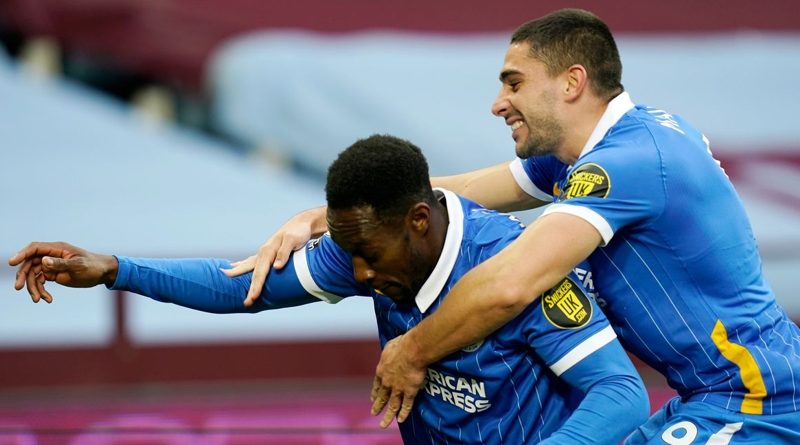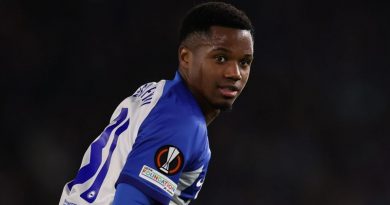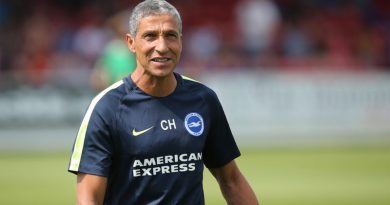Split strikers: Have Brighton stumbled across a winning formula up front?
When Dan Burn joined Tariq Lamptey, Solly March and Adam Webster on the injury list, nobody could have predicted that a lack of defenders would lead to Graham Potter rearranging his Brighton forward line into split strikers.
With a lack of options to fulfil the wing back roles in a 3-4-1-2, Potter has instead deployed Jakub Moder and Pascal Gross as narrower wide men.
The job of hugging the touchline therefore goes to Danny Welbeck and Neal Maupay, with Leandro Trossard coming from deep into the areas vacated by the two central strikers.
Explain it all to somebody who has not watched Brighton in their past two matches and it might appear as though Potter has been downing whiskey pints with Mark McGhee.
The new approach has only been in place for 180 minutes so it is still early days, but already it looks as though the Albion may just have stumbled across a winning formula.
Potter used his split strikers for the first time when Newcastle United were beaten 3-0 at the Amex as Brighton picked up their biggest (okay, it was only their second) home win of the season.
Much of the talk afterwards focussed on how bad Newcastle were. How much of that though was because Brighton made them look terrible? Bruce could find no way to deal with split strikers and as a result, the Albion ran riot.
Newcastle then went and proved that they are not as crap as was being made out by drawing with Spurs in their next match, making the hammering dished out by Brighton appear more impressive.
The Albion’s victory over their relegation rivals was followed up with an excellent first half display against Manchester United. Ole Gunnar Solksjaer’s team are second in the Premier League for a reason.
Yet for the opening 45 minutes at least, an alien who had popped down from Mars for the day with no knowledge of the table would have thought Brighton were in the hunt for the top four and United looking over their shoulders down in 16th.
Had Dean Henderson not been in such inspired form, nor Mike Dean and VAR somehow concluded that Welbeck getting grappled to the ground by Harry Maguire in the box was not a penalty, then Brighton might have even won at Old Trafford for the first time ever.
Manchester United 2-1 Brighton was certainly the closest the Albion have ever come to taking something from the Theatre of Dreams in their current spell as a top flight club.
Under Chris Hughton, United away was a match where damage limitation was in place from the start. Every man behind the ball, try and keep a clean sheet and nick something from the game.
At least that gave you a vague chance of getting a result. There was no hope of that in Potter’s first trip to United as he naively went and deployed a back three playing a high line against the pace of Marcus Rashford and Anthony Martial.
The hosts picked Brighton off on their way to a 3-1 win which could have been far more were it not for Maty Ryan. Sorry to remind all those fans out there who want to remember Ryan as the worst goalkeeper the club has ever had that, actually, he was rather good on his day.
Why then are split strikers so good for Brighton? Part of the reason is because no opposition seem to know what to do about it. Potter is almost using a W-M formation at the moment, made famous by Herbert Chapman who turned Huddersfield Town and then Arsenal into the best clubs in England throughout the 1920s and 1930s.
From the first minute against Newcastle when Welbeck and Maupay drifted into the space normally reserved for wingers, you could see the bafflement among the visiting players.
Should the Toon centre backs risk getting dragged out of position by following the players they were supposed to be marking? And if they did, what of the space that would leave for the likes of Trossard and Adam Lallana to burst into?
If the centre backs stayed put, then they had another dilemma in how to stop Trossard and Lallana exploiting that space through the middle. Do the defenders push higher up to press Brighton’s attacking midfielders or let them run onto them?
The last thing you want as a centre back is a player like Trossard building momentum to run at you at full flight, and yet if you shut him down early you risk leaving a vast swathe of space behind you.
Trossard’s opener against Newcastle came from him exploiting such space. The Belgian was found by Veltman’s forward pass in an area you would normally expect a centre forward to be occupying, before turning his man and beating Martin Dubravka from distance.
Brighton’s second goal saw Welbeck receive possession way out on the left. He cut inside and beat Dubravka from outside the box. Maupay’s effort which rounded off the scoring saw him sprinting into the box to despatch a Pascal Gross cross.
Maupay is at his best when he does not have to think too much about the finish required; when he hits one first time or plays on instinct he is more clinical and arriving later into the penalty area from wide areas, as Brighton playing split strikers now demands, seems to suit him down to the ground.
At Manchester United, we saw another positive side of Maupay’s game which the new shape brings out. Over the course of the 2020-21 season, it has become clear that Maupay is more suited to playing as a second striker.
His hold up play, ability to bring in others and his work rate is miles clear of his finishing ability and the prospect of him linking up with a genuine 30-goal-a-season striker is tantalising.
Split strikers means that the onus is less on Maupay to score and more on him creating. Before, he would never have found himself out on the right wing to deliver a peach of a cross onto the head of Welbeck to give Brighton their opener. Welbeck meanwhile had come ghosting in from his position out on left, unnoticed by Aaron Wan-Bissaka.
It was Maupay too who delivered the low ball into the box which Welbeck was trying to stretch to reach when Maguire bear hugged Dat Guy, perfectly legally apparently. Two moments which should have resulted in two Brighton goals against the mighty Manchester United both brought about by split strikers.
Playing in this way means that the middle of the park is no longer so congested, an especially important consideration against sides with the intention of just sitting back like Newcastle.
Teams used to know that if they lined up in two banks of four, Brighton lacked the guile to find a way through. Potter’s xGulls might record 60 or 70 percent possession, but often that would be from sideways pass followed by sideways pass as they were unable to open up a packed defence and not clinical enough to take chances when they come.
The Newcastle game changed all that. Welbeck and Maupay playing wide meant that there were two less blue shirts taking up space in the middle. It made the pitch wider and sewed the seeds of confusion, meaning that Brighton had less to break down to find their way to goal.
Nine of Brighton’s 11 Premier League wins since the start of 2020 have come in games in which they have had less of the ball. Based on what we saw against the Toon, split strikers has the ability to make Brighton as effective in games in which they dominate possession as they have been when beating the likes of Arsenal, Burnley, Spurs, Liverpool, The Leeds United and Aston Villa over the past 12 months.
The question now of course is how long will it last? Split strikers might have caused Newcastle and Manchester United problems, but Premier League managers are not thick – they will find out a way to counter it eventually.
Just look at Sheffield United; once the rest of the top flight got to grips with the concept of overlapping centre backs, Blades fans have had to go from dreaming of Real Madrid and Bayern Munich in the Champions League to Luton Town on a Tuesday night in the Championship.
Based on what we have seen so far, split strikers can keep Brighton in the the top flight this season. Whether the approach will be so effective in 2021-22 is doubtful, and it therefore should not cloud the club’s judgement of what really needs to happen to the Albion’s attack for next year – a new, clinical centre forward. Easier said than done, of course.




